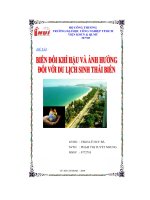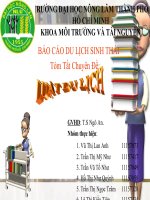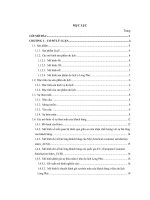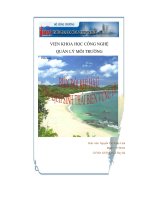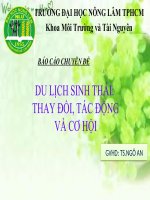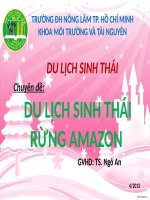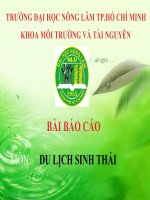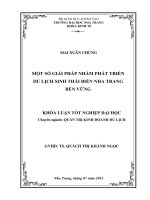Báo cáo du lịch sinh thái biển bền vững nghiên cứu so sánh vân đồng việt nam và kkeshi nhật bản
Bạn đang xem bản rút gọn của tài liệu. Xem và tải ngay bản đầy đủ của tài liệu tại đây (1.02 MB, 20 trang )
204
DU LỊCH SINH THÁI BIỂN BỀN VỮNG
NGHIÊN CỨU SO SÁNH: VÂN ĐỒN VIỆT NAM VÀ KKESHI NHẬT BẢN
Bài viết thảo luận những khó khăn trong việc phát triển du lịch sinh thái biển một cách
bền vững dựa trên những phân tích hiện trạng trong hai nghiên cứu trường hợp tại Nhật Bản
và Việt Nam. Thị trấn Akkeshi nằm ở phía Đông Bắc của Hokkaido nơi các nguồn tài nguyên
thiên nhiên phong phú như các vùng đất ngập nước Ramsar và có sự tồn tại của nhiều loại
động vật có vú như hải cẩu. Tuy nhiên, thị trấn đang phải đối mặt với xu hướng suy giảm số
lượng khách sau những kỳ vọng cao vào những năm 1990 do sự xa xôi, hẻo lánh. Ở góc độ
khác, Huyện Vân Đồn lại là một dự án mới đầy tiềm năng trong chính sách kích thích kinh tế
vùng duyên hải Quảng Ninh của chính phủ. Vân Đồn sở hữu một Công viên quốc gia với
nguồn tài nguyên thiên nhiên phong phú nhưng vẫn chưa tìm ra một hướng đi thích hợp cho
việc khai thác du lịch. Bên cạnh sự đa dạng của đặc điểm địa lý, Vân Đồn cũng là nơi ngụ cư
của một số loài rùa và nhiều loài động vật đặc sắc. Tuy nhiên trong cả hai trường hợp, việc
phát triển du lịch đều đã phải trải qua những nghịch lý giống nhau do cả những điều kiện
khách quan (như sự cạnh tranh của các các khu vực lân cận có nguồn tài nguyên thiên nhiên
tương tự) và chủ quan (như tính mùa vụ cao và phụ thuộc nhiều vào điều kiện tự nhiên). Làm
thế nào để giảm thiểu những khó khăn nhằm hỗ trợ sự phát triển bước đầu của du lịch sinh
thái là một câu hỏi cần giải đáp. Trên cơ sở những kinh nghiệm trong ngành du lịch, tác giả đã
đề xuất một số số giải pháp nhằm phối hợp giữa du lịch, sự lãnh đạo của chính quyền địa
phương, mô hình quản lý kinh doanh bền vững cũng như xem xét các mối quan hệ tương tác
giữa du lịch đại chúng và du lịch sinh thái như một giải pháp cho sự phát triển hiện nay.
SUSTAINABLE MARINE ECO-TOURISM.
A COMPARATIVE STUDY: VANDON VIETNAM AND AKKESHI JAPAN
Tran Duc Thanh
1
Tran Thi Mai Hoa
2
Abstract
The paper discusses the difficulties of developing marine eco-tourism sustainably
based on the analyses of current situations in two case studies in Japan and Vietnam.
Akkeshi Town is located in the northeastern part of Hokkaido, where the natural resources
1
Asst. Prof. Dr., Faculty of Tourism Studies, USSH, VNU
2
MA, Faculty of Tourism Studies, USSH, VNU
205
are plentiful such as the Ramsar inscribed wetland, the existence of big mammal such as
seals. However, the town is facing the decreasing trend in the number of tourists after a
high expectation in the 1990s due to an out-of the way place. Van Don District, on the
other hand, is a new and prospective project in the government’s policy to stimulate the
economy of the coastal zone of Quang Ninh. It owns a national park that offers a lot of
natural resources but has not found a skilful way to make it live hand in hand with the
exploration of tourism industry. Besides the diversity in geographical features, it is also
the habitant of some kinds of tortoise and other special animals. Nevertheless, both cases
have experienced the similar paradoxes in tourism development, coming from both
objective contexts (e.g. the competition to their neighboring areas that have quite similar
natural resources) and subjective paradigms (e.g. the high seasonality and dependency on
natural conditions). How to minimize the difficulties to support the infant development of
ecotourism is the question that needs proper answers. Based on the authors’ experience in
tourism industry, some solutions are suggested, addressing the co-operation within local
tourism, the proactive leadership of local government, the business model for sustainable
management, as well as considering the interaction relationship between mass tourism and
ecotourism as a solution for current development.
Keywords: ecotourism, sustainable tourism, tourism management, Vietnam, Japan
I. Introduction
Coastal and marine areas have always been noticed as important but complex
zones for any government of those countries that have a large area of marine territory
like Japan and Vietnam. For the nature of a coastal zone, which offers a wide range
and a variety of natural resources, tourism development is often integrated in local
development strategies to take advantage of this fruitful industry. However, as two
sides of a coin, impropriate application of tourism may also lead to undesirable effects
as well as many other conflicts. To make tourism eco-friendly, many governments
have stated to encourage the orientation for sustainable tourism and ecotourism
development (Vietnam Prime Minister 2010; Japan Ministry of Environment 2008).
Nevertheless, it is more an ideal than a reality to achieve what is truly called
“sustainable tourism”. If it is true that “practice makes perfect”, then valuable lessons
from other areas and other countries is worth considering.
206
In this paper, the authors focus on the development of marine tourism in two
case studies in Japan and Vietnam. Based on two case studies in Akkeshi Town
(Hokkaido, Japan) and Van Don (Quang Ninh Province, Vietnam), the authors discuss
difficulties of ecotourism development in coastal regions, and suggest oriented
solutions for the better application of ecotourism and sustainable tourism in marine
areas. The learnt lessons are expected to give a second thought for strategy-makers of
local development based on tourism industry.
II. Basic concepts
1. Ecotourism development
As tourism studies needs a multi-disciplinary approach, the authors apply
several approaches at the same time, including the supply-demand approach in
economics, tourism system approach in tourism geography, tourist behaviour approach
in sociology, etc. Particularly, the authors regard ecotourism as "philosophy of
sustainability in tourism industry". In other words, to be ecotourism, it must satisfy
three key criteria (Fig.1.).
Moreover, to develop "genuine ecotourism", a community-based approach is
highly recommended in ecotourism projects. In coastal and marine areas, fishermen's
n
n
a
a
t
t
u
u
r
r
e
e
-
-
b
b
a
a
s
s
e
e
d
d
Learning
orientation
Sustainable
principles
Fig.1.
Three key criteria of ecotourism
(Illustrated from Garrod & Wilson 2003)
207
participation is indispensable for the success of local tourism industry. As a result, a
solution will emphasize the co-existence between fishermen and their environment.
2. Marine ecotourism
Few academic papers mention marine ecotourism as a separate topic from
various schools of thought in ecotourism. In fact, marine ecotourism concept refers to
geographical classification of ecotourism development in coastal and marine areas in
comparison with that of terrestrial areas. It covers ecotourism development in
foreshore, offshore and coastal zones (Garrod & Wilson 2003).
Main marine ecotourism activities are sea-based (particularly focusing on mega
fauna and “opportunistic sightings” or opportunities to observe typical animals).
Nevertheless, land-based activities are also acceptable and are considered as a
substitute for sea-based activities in case of unfavourable conditions of local weather.
Furthermore, non wildlife-based activities (e.g. those focus on unique cultural and
heritage characteristics of coastal regions and communities) are also considered a form
of ecotourism.
In comparison with terrestrial ecotourism, marine ecotourism is more dynamic,
open and sensitive as marine wildlife is “highly mobile”, “remote and diffuse”.
Pollutions and bad impacts are more serious and widespread due to “interconnectivity”
by water environment, almost non-spatially compartmentalized (Garrod & Wilson
2003). Tourism resources are more likely to be in modified condition.
Fishermen are the main component of villagers living in marine ecotourism
destinations. In comparison with people in remote mountainous areas, they are more
open and more sensitive to tourism business. However, their income is less stable in
terms of seasonality, endangered by the increasing impacts of global issues such as
global warming.
III. Research areas
1. Akkeshi Town (East Hokkaido, Japan)
208
Akkeshi Town has the total area of 739km
2
, with the population of 11,164
people (2008) (population density is 15 people/km
2
), is the habitat for 4,441
households. Most of them are fishermen. 31.8% of the labor force work in agriculture,
forestry and fishery (23.8% of which work in fishery), 23% in industry and
construction, 45.2% in service sector (2005). 60% of fishermen are males. The main
product is seaweed or kelp.
Akkeshi Town was selected as the first place to conduct a case study for several
reasons. First, it was recommended by Ubakata (2006) as a town rich of natural
resources in its prefectural parks. Notably is a vast area of wetland that was inscribed
in the Ramsar Convention and had been continuously protected by a number of NPO
and environmental organizations.
Fig. 2. Akkeshi Town and its eco-tours
(Source: Tran Thi Mai Hoa, PhD dissertation)
2. Van Don District, Quang Ninh Province, Vietnam
Van Don is made of over 600 islands and small islets in the northeast of the
Tokin. It has the total area of 553.2km
2
, with the population of 41,447 people (2008)
209
(population density 75 people/km
2
). Most of them are fishermen. 76.8% of the labor
force work in agriculture, forestry and fishery (25.7% of which work in fishery), 6% in
industry and construction, and 17.2% in service sector (2005). The main product is “sa
sung”. Their income is unstable.
Fig. 3. Administrative map of Van Don District
Van Don has been noticed since the Van Don Economic Zone was settled up
and a vast investment for infrastructure was started. With the special position, tourism
and recreation industry of Van Don seems to be a focus lens in many regional master-
210
planning strategies. However, in the contrary to prospectively projected, if not to be
overestimated, number on paper, tourist arrivals in the last period just had a slight
increase.
IV. Tourism development in Akkeshi Town, Hokkaido
* Resources for tourism
Considering the topographical features, Akkeshi Town is likely to offer a wider
range of natural resources; particularly, sea and marine resources. Events that relate to
seafood such as Akkeshi Oyster Festival attract thousands of tourists per year,
accounting for one of the largest percentage shares in tourist arrival numbers (Tab.1).
Gourmet and cuisines is also the theme for tourism activities, bringing main revenue in
its tourism industry.
Beautiful landscapes that can be observed from Aikappu, Aininkappu, Daikoku
Island, etc is another attractiveness of Akkeshi Town (Fig.2). Noticeably, colourful
flower fields such as Ayameke-hara, Nenohi Park are gathering places for tourists in
late springs and oyster festivals.
Recently, the inscription of Bekanbeushi as a Ramsar site and the increasing
interest of environmentalists for this site created another tourist place in the wetland
region, but the number of tourists is still limited (Tab.1.).
* Tourism situation
Akkeshi Town was known by domestic tourists for quite a long time,
particularly among leisure-seekers from Kushiro City. However, after the high peak in
1994, domestic tourists have gradually decreased (Fig.3). Statistics showed that about
90% of tourists came from within Hokkaido, and over 90% were one-day visitors.
Foreign tourists were exceptionally few, less than a hundred people per year,
accounting for only 0.03% of all tourists per annum.
211
0
100
200
300
400
500
600
700
1989 1994 1999 2004 2009
Fiscal
year
Thousands of
domestic tourists
Tourists from Hokkaido Tourists from other prefectures
Fig.3 Domestic tourists to Akkeshi Town
(period 1989 to 2009)
(Source: based on Akkeshi Town Statistics)
Tab.1. Domestic visitors to Akkeshi by
tourist places and tourist
attractions(fiscal year 2009)
Places of
interests
Tourists
from
Hokkaido
Tourists
from other
prefectures
Parks and
gardens
88,323
(29.39%)
15,790
(42.88%)
Wetland
5,532
(1.84%)
3,464
(9.41%)
Museums and
historic sites
27,738
(9.23%)
4,667
(12.67%)
Festivals and
special events
4,933
(1.64%)
25
(0.07%)
Food and
souvenir
shops
173,966
(57.89%)
12,875
(34.97%)
Total
300,492
(100%)
36,821
(100%)
Source: based on Statistics of
Department of Local Development
(Akkeshi Town 2010), the authors
compiled.
The tourist season is from May to November with peak in Augusts. In winter,
the tourist number is exceedingly low.
* Three ecotours
Ecotourism in Akkeshi Town is under the control of a complexity of agencies.
While Department of Local Development takes charge of tourism facilities
improvement and promotion (such as organizing festivals and events, delivering
tourist information, etc.), NPO and environmental organizations care for preserving
the Ramsar resources and environmental education trainings. In Japan, managing eco-
tours is the responsibility of individuals and cooperative enterprises. Due to the lack of
big tour operators, ecotours in Akkeshi Town are managed by an enfranchise
enterprise, called Conchiglie, founded in 1994. It, in fact, is a terminal for by-passers
to take a rest and consume local souvenirs. Nonetheless, unlike other simple bus
terminals, it functions a complex role, i.e. a tourist information center, local food
restaurant, environmental exhibition room, conservation center, etc, under a united
director board. Being a self-control enterprise, Conchiglie is partly municipality-
212
owned, and works hand in hand with the local government for environment
conservation. Its strategy is to “activate Akkeshi Town”.
Three tours that Conchiglie is operating can potentially be ecotour programs.
They are river touring by canoe or canoeing tour, seal watching tour, and clam-
collecting tour. Other reasons for recognizing them as part of eco-tours are they are all
new forms of tours that were just born in the 1990s (1995 for canoeing tour, 1998 for
seal-watching tour, and 1999 for clam-collecting tour); and their number of tourists
they serve are limited as against to the large number of mass tourism.
Table 2 highlights basic information and figures 4 and 5 illustrate the situation
of business and the seasonality of such tours.
Tab.2. Three ecotours in Akkeshi Town
Name of
tour
Average
hours
No. of
months in
operation
Maximum
no. of
participants
Price
(per
person)
Tour
guides
Supervisors
Canoeing
2 hours
(2 times/
day)
6 months
(1st May.
to 31st
Oct.)
40 people (2
people and 1
instructor per
canoe)
JPY8000
(4-10
people);
JPY5000
(11-40
people)
One man (a
carpenter
and
canoeing
maker)
Conchiglie
NPO: Bird
Observation
Center
Seal-
watching
1.5
hours
(2 times/
day)
6 months
(1st May.
to 31st
Oct.)
No limitation
(max. 10
people and 1
guide/boat)
JPY5000
(apply for
5 people
upwards)
Four
fishermen
(in their
thirties,
fifties)
Conchiglie
Clam-
collecting
Not
specific
3 months
(mid-Apr.
to mid-
July)
No limitation JPY2000 Volunteer
fishermen
Conchiglie
Agricultural
Association
Cooperatives
(
Source: based on Conchiglie brochure of experience tour and interviews)
213
0
100
200
300
400
500
600
700
800
1995 2000 2005
Fiscal year
No. of partic ipants
Canoeing tour Seal-watching tour
Clam-collecting tour
Fig.4. Three typical ecotours in Akkeshi
Town
(Source: based on Conchiglie Statistics)
0
50
100
150
200
Apr.
May
Jun.
Jul.
Aug.
Sep.
Oct.
Nov.
Dec.
Jan.
Feb.
Average no. of participants
canoeing tour seal watching tour
clam-watching tour
Fig.5. Tourist seasonality of three
ecotours by the average participants by
month from their operation year
(Source: based on Congile
Statistics)
IV. Tourism development in Van Don District, Quang Ninh Province
*Natural resources
The natural resource that is valuable for ecotourism development concentrates
in the protected areas of Bai Tu Long National Park, which stands out as one of only
seven national parks that have both territorial and marine areas. The park is famous for
a bio-diversity (Le Van Lanh, 2008) of six ecosystems, including broad-leafed
evergreen tropical forests on limestone and on soil islands, littoral ecosystems, shallow
water ecosystems, mangrove ecosystems, and coral ecosystems (Ibid.).
However, its competitive advantages of Vandon are their unspoilt beaches and
marine landscapes, with both karst-formed islands as a continuance of Ha Long Bay’s
geomorphologic feature, and soil-covered islands, which dominate the region.
For Vietnamese tourists, other cultural and archaeological resources such as the
complex of Quan Lan monuments (i.e. ‘Dinh-chua-mieu-nghe’ or community house,
temple, shrine and joss-house) and its related festivals at spring. Besides, traditional
handicrafts, specialties and cuisines, and people’s lifestyle that were ‘colored by waves
214
and winds of the sea’ are also invaluable resources to diversify visitors’ experience to
this lovely island.
*Tourism situation
The figures of tourist arrivals have showed an upward tendency in the last 10
years (Fig.3). For example, in 2001 the district host only 30,000 visitors, but in 2007
the number of visitors rocketed to around 276,000. About 90% of visitors are domestic.
Inbound tourists are rare, from Europe, China, etc.
Table
Table Table
Table 3.
3.3.
3.
Num
NumNum
Number of registered accommodations in Van Don (period 2001
ber of registered accommodations in Van Don (period 2001ber of registered accommodations in Van Don (period 2001
ber of registered accommodations in Van Don (period 2001-
-2007)
2007)2007)
2007)
Items 2001 2004 2005 2006 2007
No. of registered
accommodations
(in which qualified
standard)
10
-
12
-
35
-
40
-
42
21
No. of registered
rooms
(in which qualified
standard)
80
-
330
-
381
-
424
254
551
329
Source: Department of Culture, Tourism and Sports, Van Don (2008)
Figure 6. Tourist arrivals in Van Don District (period 2001-2007)
Source: Department of Culture, Tourism and Sports, Van Don (2008)
215
*Ecotours
Ecotours have often appeared in papers but not really been implemented in
practice. Only researchers and students of universities are their eco-tourists. Other
favorable activities for mass markets are beach-related activities (e.g. sun-bathing,
swimming), festivals, and religious and historical places visiting.
Economic benefit flows into the hands of a few households who open
accommodations for tourists and supply basic demand like food and beverage,
transportation in offshore islands. Though their profit tends to increase, they have to
compete unfairly with outsiders, and consequently, there seem to be a big room for
“economic leakage”. Environmental impacts are to be increasing in accordance with
the growth of new infrastructure and tourism facilities.
V. Difficulties for ecotourism development in 2 case studies, and suggested
solutions
1. Difficulties of marine ecotourism development in both case studies
The two case studies, though in different countries, illustrate similar difficulties
of ecotourism development in marine and coastal areas.
First, there are difficulties coming from the paradox of marine tourism itself.
Marine tourism and coastal tourism has a high demand but suffers a distinctly seasonal
pattern. For example, in the Akkeshi case, seal-watching tour and canoeing tour are
highly concentrated on warmer season from April to October, with high peaks on
April-May, and September-October. The same pattern can be observed in beach
relaxation among tourists to Van Don, with a peak for Vietnamese tourists in late April
to June, and for foreign tourists in October-November. This characteristics is
dominated by the weather condition, thus, it is hard to make a change. Another
difficulty of marine tourism development comes from the “interconnectivity” as
mentioned earlier. For example, the Akkeshi’s fishermen suffers from the fertilize and
wastes of dairy farms run directly from the upper hills to Akkeshi Lake, which reduces
their productivity of aquaculture.
Secondly, it is the difficulty brought about by the ecotourism paradox itself.
The type of original ecotour is not very popular for the majority of domestic tourists.
216
As a result, it leads to the impact of niche market, and low economic return. On the
other hand, if the managers try to widen its tourist demand, they have to lower the
fence of environment conservation, which conflicts the principle of ecotourism: the
responsible tourism for the environment. Akkeshi Town, for example, has a very
limited number of participants to their three ecotours in comparison with the total
tourist arrivals (about less than 1%). For Van Don, that number is much lower as
ecotours have not officially come into operations for all tourists.
Thirdly, it is the competition from famous tourist attractions nearby. In the case
of Akkeshi, the total number of tourists is going downward as the town could not
develop a distinguishable tourism image from other surrounding areas. Canoeing tours
is a common form of activity in almost every wetland that is easy to find throughout
the region. Thus, in comparison to infamous wetlands like Kushiro, Nemuro, etc.,
Akkeshi Wetland is only popular for local residents than for tourists from other
prefectures. Moreover, if compared with Shiretoko (a World Natural Heritage to the
north since 2005) or Akan tourist attractions, Akkeshi is much less famous, and
tourism industry has little room to develop due to the unavailability of infrastructure.
Van Don, though given high expectation, suffers similar issues, both from the
competitiveness of surrounding places, types of tourism, and from the inconvenient
access.
As a result of these difficulties, it is easy to explain why the income increased
by tourism activity is so modest in both case studies. In Akkeshi, the interviews with 3
tour-guides re-confirm that participating in ecotours does not help them earn money
for their living but a “volunteer” activity (日向さん, 35 year-olds). For the Van Don
case, the number of non-participation in tourism activity is about 80% (see Tab.4).
Tab.4. Survey on added income from tourism-related activities to household income
Village No. of
households
surveyed
Added income from tourism
(households)
Not participated
households
1-
10%
11-
30%
31-
50%
Over
50%
No. of
households
%
Minh Chau 52 5 1 5 0 41 79%
(Source: Questionnaire survey in March, 2010)
217
2. Suggested lessons for marine ecotourism in Vietnam
a. Critical issues for ecotourism development in Vietnam, case study of Van
Don
Related to this topic, Quach Mai Hong (2003, cited in Jimenez, p.15) points out
that the main difficulties for the development of ecotourism in Vietnam are: i) lack of
knowledge about ecotourism (ii) lack of training in ecotourism staff; (iii) difficulty in
achieving environmental protection in the face of poverty, and (iv) lack of funds to
improve tourism installations. Some similar opinions are also reported in a report of
FUNDESCO, an NGO that has implemented many projects at national parks of
Vietnam, (Jimenez), Suntikul et al. (2010) and others.
We can summarize the main difficulties in Van Don as follows:
Limitations in public awareness of ecotourism concept: in our survey in
2009, most of the local people (93%) vaguely think of ecotourism as a nature-based
activity as simple as going to a beach, swimming and playing. Another large number
refused to answer because they “have heard about it” but can figure out what it is or
“don’t care about it”.
The lack of environmental practice: This is partly because environmental
regulations, though not few in numbers, have not been strictly enforced and obeyed. In
Van Don, for example, the situation can be observed, and the reason, as the board of
Bai Tu Long National Park explains, is the lack of human resource, budget against the
vast and complex of the allotted territory.
Hindrance from the social acknowledgement of tourism and ecotourism:
For many rural areas in Vietnam, tourism is still considered to be related to social evils,
prostitution and HIV-AIDS. This unhealthy opinion of tourism in general and
ecotourism in particular is not at all rare. In fact, a casual talk with a village’s
municipal official in a drinking party reveals his viewpoint that prostitution should be
recommended if Van Don’s tourism is to develop, which amazed the author.
Concerned the quality of an accommodation for tourists, local people in Minh Chau
village believed that tourists want to live in big hotels rather than their daily houses,
which prevent them from participating in local tourism industry.
218
Insufficient concern of the central governmental: Though Vietnam had
the “Ecotourism Development Strategy” conference in 1999, ecotourism has not
received the sufficient concern of the central government such as an Ecotourism Law
as in Australia, for instance. Suntikul et al. (2010:206) criticize that “government
indifference and corruption, lack of involvement of locals in planning and the fact that
most promoters of tourism tend to be large non-local concerns still serve as barriers to
eco-tourism development (Cresswell & McLaren, 2000, p.294; Wurm, 1999, pp.5,20)
(…) At the governmental level, responsibilities, interdependencies and interests are
often indistinct or redundant, complicating the administrative process and the efforts of
conservation organizations (Phan et al., 2002; Wurm, 1999, p.17).” It stays value for
the case of Van Don.
The lack of institutional framework and cooperation and the overlapping
in responsibilities: Many comments by ICEM (2003:43) or Sage & Nguyen Cu (2001)
(cited in ICEM, 2003a, p.94) when pointing out the reasons for the “disappointing”
performance of ICDP in Vietnam, addresses the “poorly defined and/or overlapping
institutional and administrative responsibilities, particularly in the buffer zones of
SUFs [Special Use Forests]” as one of the big issues. For the Van Don case, the
cooperation and collaboration between the People Committee, the Forest Guards, and
the National Park board shows many overlapping as well as faults.
Conflicts in land use: In Vietnam, only the government has the
ownership of land. As a result, the development of tourism projects, often in peripheral
areas, may easily lead to the conflicts of land use because of “lack of involvement of
locals in planning” (Suntikul et al. 2010:206). In the case of Van Don, the conflict
appears between Bai Tu Long ecotourism resort in Cai Bau mainland and fishermen
on the usage of the beach for tourists and for “illegally” shipworm digging. Similarly,
the beach in Minh Chau village, which is just few hundred meters away from the
settlements of Minh Chau people, was taken out off the local’s use, when the land is
hired by another resort owner, who got one-year contract with the national park
management board.
219
b. Solutions
Under that overall conditions, developing a truly ecotourism destination is a
challenging task. The authors will recommend some oriental suggestions based on the
lessons from Akkeshi Town and Van Don District, to partly solve the three
aforementioned difficulties in the earlier part.
For the difficulty of seasonality, the most available solution is to diversify the
activity and tour products to overlap shallow seasons. The solution Akkeshi has done
is creating a new tour that is less weather-dependent and also represents the
competitive advantage of the local seems to take effects. Thus, Van Don Tourist
managers should look for other products that distinguish Van Don with the
neighborhoods. Experience tours on “sa sung" digging skills seem to be highly
applicable in the case of Van Don as tourists can go all year round. Another possible
product is “visiting jelly-fish processing” which is much less weather-dependent, and
often occurs at February or March, off the mass tourist’s high peak. However, it
requires advanced and continuous efforts to make such tours into reality, such as tour-
guide training, marketing, demand detecting, etc. Consequently, a local association
who takes charge of local tourism business is a must.
Secondly, to make ecotour no longer a niche market, it is necessary to make the
change on ecotourism awareness among policy-makers, tourism managers, and also
local communities. Rather than a typical tour to un-spoilt regions, the adaptable
approach of “experiential tour” like that of Japan can be a suitable one for Vietnam.
Human-life with his surrounding environment, instead of purely nature, can take the
center point of such experiential tour to increase the chance of participation for local
people. Another solution that combines ecotourism with mass tourism, applying
“ecologicalizing techniques”, is worth considering. Those techniques includes resizing
and minimizing tour groups, reducing tourist consumption, making use of available
infrastructure and lodging, increasing the functions of a tourist facility, etc. Take the
case of Akkeshi for example. All three ecotours are promoted by one organization in
the Conglie Complex. This Complex is also occupied as a tourist restaurant, tourist
information center, local retail sales and souvenir selling, environmental educational
center, and so on. In Van Don, we can make use of the educational center, sponsored
220
by earlier conservation project, to be a future tourist center, local restaurant or
souvenir selling point. This center has an ideal location for such a task.
Thirdly, it is clear that ecotourism could not healthily develop without the
development of traditional tourism. The more other types of tourism available, the
more possible ecotourism development can achieve (but the vise versa may not be
true). Thus, the view on the relationship between ecotourism and other tourism should
be shifted from a competitive relationship to a win-win relationship. This is most
likely effective for newly developed destinations, where the abundance of natural
resources to offer for tourists is quite modest, such as rural areas and economically
undeveloped regions. This assessment goes unanimously with a previous comment of
Weaver (1998) on ecotourism in less developed countries. The encouragement of big
investors from other areas to invest and do business in Van Don is obviously a good
strategy to create foundations for the development of sustainable tourism in the future
(if it is responsibly and well-managed). However, the local government at the same
time should give ways for the locally-owned small business to participating in this new
field, as they will be the long-life consistent owner of Van Don.
Reasonably, by cooperating with other traditional tourism, “ecotour” can take
advantage of the informative and various channel of traditional tourism to increase
their target market. In other words, we should think of the change in management
instead of the change in tour type that touches the key issues of ecotourism principles.
We have highlighted the process that tourism managers in Van Don should
consider to successfully achieve sustainable marine tourism development in the
district:
1. Establish a committee to discuss about tourism development at local scale,
including local government members, local tourism businesses, representatives of
local communities, national park manager, etc.
2. Under the unanimity of this committee, draft the rule and regulations for
ecotourism management in Van Don, adaptable to the regional development plan; and
to establish local tourism association.
221
3. Local tourism association continues to create the network of coordinator at
smaller scale and look for new and possible tour products.
4. Select most competitive tour products and do the advance marketing and
other pilot tests, and then promote the tour if appropriate.
5. Manage the output, input investment to make the business economically
effective and socially effective.
We hope that by setting up this local tourism association, it will shed the lights
for the development of ecotourism and sustainable tourism in Van Don in general and
in other regions in Vietnam in particular.
VI. Conclusion
Marine areas are one of the main foci for the development of ecotourism to
fight against the boom of mass tourism and its harm to the environment deterioration.
With the widespread tendency of ecotourism by nature, marine and coastal zones have
become more important destinations in order to attract foreign exchange in both
developing and developed countries. However, to steward the development of
ecotourism toward a sustainable form, the involvement of local communities in marine
and coastal zones - is a key to success.
Focusing on the two case studies, the authors emphasize the major difficulties
of marine ecotourism development in Japan and Vietnam, and suggest oriental
solutions based on the co-existent relationship between fishermen and their habitat, the
win-win relationship between ecotourism and other types of tourism, including
traditional tourism for the case of Van Don.
It is also learnt that ecotours and ecotourism forms in practice are varied as long
as it satisfies the positive "triple bottom line" (Buckley 2003). A country, hence, can
flexibly and creatively adopt the concept to suit its own condition. But the government
and particularly, the local government have to fulfill their function as an agent to
balance the profit among shareholders in order to get the equilibrium point that the
society is expecting.
222
References
1. Adachi Yoshimichi 2008. “Examining Ecotourism in the Japanese Context, Using a
Case Study of Tottori Prefecture.” in East Asian Inter-regional Tourism Forum
Academic Symposium 2008: “What does ECO-Tourism mean and what is the best way
to develop it”, in Mongolia. Retrieved from
Visited in November, 2009.
2. Garrod, B. and Wilson, J.C. (eds) (2003). Marine Ecotourism: Issues and Experiences,
Frankfurt.
3. ICEM (2003a). Lessons learned in Cambodia, Lao PDR, Thailand and Vietnam” Review
of Protected Areas and Development in the Lower Mekong River Region. Indooroopilly,
Queensland, Australia.
4. ICEM (2003b). Vietnam National Report on Protected Areas and Development. Review
of Protected Areas and Development in the Lower Mekong River Region. Indooroopilly,
Queensland, Australia.
5. Japan Ministry of Environment. Ecotourism Promotion Law 2008
6. Jimenez, J. Garcia-Herrera (n.d.). Handbook of ecotourism in Protected Areas of
Vietnam. Fundesco. />content/uploads/downloads/2011/02/Handbook-of-Ecotourism-in-Protected-Areas-of-
Vietnam.pdf. (last assessed on May 20th, 2012)
7. Le Van Lanh (ed.) (2008). BaiTuLong National Park [Vườn Quốc gia Bái Tử Long].
NXB Thanh niên, Hà Nội.
8. Ministry of Environment 2004. Eko tsurizumu ni kansuru kokunaigai no torikumi ni
tsuite [Strategy for Ecotourism within and without the Nation] (in Japanese).
9. Miyakawa, Hiroshi. (2002). “Ecotourism in Japan,” Linking Green Productivity to
Ecotourism: Experiences in Asia-Pacific Regions, Tokyo: Asian Productivity
Organization. pp.108-117.
10. Phan Nguyen Hong, Quan Thi Quynh Dao, Le Kim Thoa (2002). Ecotourism in
Vietnam: Potential and Reality. In APO (ed.) Linking Green Productivity to Ecotourism:
Experiences in Asia-Pacific Regions. Tokyo: Asian Productivity Organization.
11. Quach Mai Hong (2002). Ecotourism Case Studies in Vietnam. In APO (ed.) Linking
Green Productivity to Ecotourism: Experiences in Asia-Pacific Regions, pp.264-269.
Tokyo: Asian Productivity Organization.
12. Shikida Asami, Morishige Masayuki, Takagi Harumitsu, and Miyamoto Hideki (eds.)
2008. Chiiki kara ekotsurizumu_kankou/kouryu ni yoru jizoku kanousei na chiiki zukuri
223
[Ecotourism through Case Studies: Sustainable Local Development basing on Tourism
and Urban-Rural Interaction]. Tokyo: Gakugei. (in Japanese)
13. Statistics of Akkeshi Town. (2008). Akkeshi Town.
14. Suntikul, W., Butler, R., and Airey, D. (2010). Implications of political change on
national parks operations: doi moi and tourism in Vietnam’s national parks. Journal of
Ecotourism 9, No.3. Taylor and Francis.
15. The Prime Minister of Vietnam [Thu tuong Chinh phu]. (2011) Resolution of ‘the
Strategy for Tourism Development of Vietnam 2010-2020, and Vision to 2030 [Chien
luoc phat trien du lich Viet Nam giai doan 2010-2020, tam nhin toi 2030] (in
Vietnamese), No.2473 QD/TTg, passed on Dec.30, 2011.
16. The Prime Minister of Vietnam [Thủ tướng Chính phủ] (2006). Socio-economic zone
development: VanDon economic zone, Quang Ninh province (“Phát triển khu kinh tế
xã hội: Khu kinh tế Vân Đồn, tỉnh Quảng Ninh”), Resolution No. 785/QD-TTg, dated
31st, May, 2006 (Quyết định 785/QĐ-TTg ngày 31/5/2006).
17. The Prime Minister of Vietnam [Thủ tướng Chính phủ] (2011). Resolution of ‘the
Strategy for Tourism Development of Vietnam 2010-2020, and Vision to 2030’ No.2473
QD/TTg, passed on Dec.30, 2011.
18. UBND Van Don (2009). Master planning for Van Don Economic Zone (in Vietnamese).
19. Ubukata, Hidenori (2006). “Toward Ecotourism in which Nature Experience and Nature
Conservation are Harmonized”, Kushiro Ronshu, Journal of Hokkaido University of
Education at Kushiro. No.28. pp.171 179 (in Japanese).
20. Weaver, D. (1998). Ecotourism in the Less Developed World. CAB International.
21. Weaver, D. and Lawton, L. (2007). “Twenty Years on: the State of Contemporary
Ecotourism Research,” Tourism Management 28. pp. 1168-1179.
22. Yurie Kaizu & Akio Maita 2004. "The Study on Overview and Prospect of Japanese
Ecotourism". In Noriaki Nishiyama (ed.) 2004. Current Status and Issues of Cultural
Herigate Management and Tourism. Osaka: National Museum of Ethnology, (pp.211-
227). (in Japanese)
